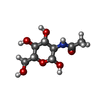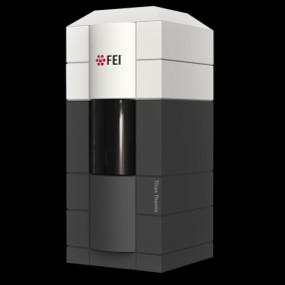[English] 日本語
 Yorodumi
Yorodumi- PDB-9c3c: Cryo-EM structure of native dystrophin-glycoprotein complex (DGC) -
+ Open data
Open data
- Basic information
Basic information
| Entry | Database: PDB / ID: 9c3c | ||||||
|---|---|---|---|---|---|---|---|
| Title | Cryo-EM structure of native dystrophin-glycoprotein complex (DGC) | ||||||
 Components Components |
| ||||||
 Keywords Keywords | MEMBRANE PROTEIN / beta-helix / sarcolemma / glycosylation / muscular dystrophy | ||||||
| Function / homology |  Function and homology information Function and homology informationsarcoglycan complex / coronary vasculature morphogenesis / muscle attachment / dystroglycan complex / nerve maturation / retrograde trans-synaptic signaling by trans-synaptic protein complex / contractile ring / morphogenesis of an epithelial sheet / microtubule anchoring / dystrophin-associated glycoprotein complex ...sarcoglycan complex / coronary vasculature morphogenesis / muscle attachment / dystroglycan complex / nerve maturation / retrograde trans-synaptic signaling by trans-synaptic protein complex / contractile ring / morphogenesis of an epithelial sheet / microtubule anchoring / dystrophin-associated glycoprotein complex / laminin-1 binding / photoreceptor ribbon synapse / basement membrane organization / dystroglycan binding / vinculin binding / branching involved in salivary gland morphogenesis / myelination in peripheral nervous system / commissural neuron axon guidance / protein-containing complex localization / node of Ranvier / cardiac muscle cell contraction / cardiac muscle tissue development / cardiac muscle cell development / structural constituent of muscle / muscle organ development / heart contraction / response to muscle activity / regulation of synapse organization / epithelial tube branching involved in lung morphogenesis / regulation of neurotransmitter receptor localization to postsynaptic specialization membrane / alpha-actinin binding / membrane protein ectodomain proteolysis / basement membrane / heart morphogenesis / calcium ion homeostasis / negative regulation of MAPK cascade / negative regulation of phosphatidylinositol 3-kinase/protein kinase B signal transduction / tubulin binding / SH2 domain binding / negative regulation of cell migration / sarcoplasmic reticulum / filopodium / calcium-mediated signaling / sarcolemma / GABA-ergic synapse / regulation of synaptic plasticity / cell-cell junction / protein transport / lamellipodium / actin binding / virus receptor activity / postsynaptic membrane / cytoskeleton / intracellular signal transduction / membrane raft / external side of plasma membrane / focal adhesion / calcium ion binding / protein-containing complex binding / extracellular space / extracellular region / nucleoplasm / plasma membrane / cytoplasm Similarity search - Function | ||||||
| Biological species |  | ||||||
| Method | ELECTRON MICROSCOPY / single particle reconstruction / cryo EM / Resolution: 4.3 Å | ||||||
 Authors Authors | Liu, S. / Su, T. / Xia, X. / Zhou, Z.H. | ||||||
| Funding support |  United States, 1items United States, 1items
| ||||||
 Citation Citation |  Journal: Nature / Year: 2025 Journal: Nature / Year: 2025Title: Native DGC structure rationalizes muscular dystrophy-causing mutations. Authors: Shiheng Liu / Tiantian Su / Xian Xia / Z Hong Zhou /  Abstract: Duchenne muscular dystrophy (DMD) is a severe X-linked recessive disorder marked by progressive muscle wasting leading to premature mortality. Discovery of the DMD gene encoding dystrophin both ...Duchenne muscular dystrophy (DMD) is a severe X-linked recessive disorder marked by progressive muscle wasting leading to premature mortality. Discovery of the DMD gene encoding dystrophin both revealed the cause of DMD and helped identify a family of at least ten dystrophin-associated proteins at the muscle cell membrane, collectively forming the dystrophin-glycoprotein complex (DGC). The DGC links the extracellular matrix to the cytoskeleton, but, despite its importance, its molecular architecture has remained elusive. Here we determined the native cryo-electron microscopy structure of rabbit DGC and conducted biochemical analyses to reveal its intricate molecular configuration. An unexpected β-helix comprising β-, γ- and δ-sarcoglycan forms an extracellular platform that interacts with α-dystroglycan, β-dystroglycan and α-sarcoglycan, allowing α-dystroglycan to contact the extracellular matrix. In the membrane, sarcospan anchors β-dystroglycan to the β-, γ- and δ-sarcoglycan trimer, while in the cytoplasm, β-dystroglycan's juxtamembrane fragment binds dystrophin's ZZ domain. Through these interactions, the DGC links laminin 2 to intracellular actin. Additionally, dystrophin's WW domain, along with its EF-hand 1 domain, interacts with α-dystrobrevin. A disease-causing mutation mapping to the WW domain weakens this interaction, as confirmed by deletion of the WW domain in biochemical assays. Our findings rationalize more than 110 mutations affecting single residues associated with various muscular dystrophy subtypes and contribute to ongoing therapeutic developments, including protein restoration, upregulation of compensatory genes and gene replacement. | ||||||
| History |
|
- Structure visualization
Structure visualization
| Structure viewer | Molecule:  Molmil Molmil Jmol/JSmol Jmol/JSmol |
|---|
- Downloads & links
Downloads & links
- Download
Download
| PDBx/mmCIF format |  9c3c.cif.gz 9c3c.cif.gz | 530.7 KB | Display |  PDBx/mmCIF format PDBx/mmCIF format |
|---|---|---|---|---|
| PDB format |  pdb9c3c.ent.gz pdb9c3c.ent.gz | Display |  PDB format PDB format | |
| PDBx/mmJSON format |  9c3c.json.gz 9c3c.json.gz | Tree view |  PDBx/mmJSON format PDBx/mmJSON format | |
| Others |  Other downloads Other downloads |
-Validation report
| Summary document |  9c3c_validation.pdf.gz 9c3c_validation.pdf.gz | 1.7 MB | Display |  wwPDB validaton report wwPDB validaton report |
|---|---|---|---|---|
| Full document |  9c3c_full_validation.pdf.gz 9c3c_full_validation.pdf.gz | 1.8 MB | Display | |
| Data in XML |  9c3c_validation.xml.gz 9c3c_validation.xml.gz | 78.5 KB | Display | |
| Data in CIF |  9c3c_validation.cif.gz 9c3c_validation.cif.gz | 119.7 KB | Display | |
| Arichive directory |  https://data.pdbj.org/pub/pdb/validation_reports/c3/9c3c https://data.pdbj.org/pub/pdb/validation_reports/c3/9c3c ftp://data.pdbj.org/pub/pdb/validation_reports/c3/9c3c ftp://data.pdbj.org/pub/pdb/validation_reports/c3/9c3c | HTTPS FTP |
-Related structure data
| Related structure data |  45165MC M: map data used to model this data C: citing same article ( |
|---|---|
| Similar structure data | Similarity search - Function & homology  F&H Search F&H Search |
- Links
Links
- Assembly
Assembly
| Deposited unit | 
|
|---|---|
| 1 |
|
- Components
Components
-Protein , 9 types, 9 molecules ABDabdgnV
| #1: Protein | Mass: 67623.688 Da / Num. of mol.: 1 / Source method: isolated from a natural source / Source: (natural)  |
|---|---|
| #2: Protein | Mass: 15714.142 Da / Num. of mol.: 1 / Source method: isolated from a natural source / Source: (natural)  |
| #3: Protein | Mass: 427942.781 Da / Num. of mol.: 1 / Source method: isolated from a natural source / Source: (natural)  |
| #4: Protein | Mass: 35969.039 Da / Num. of mol.: 1 / Source method: isolated from a natural source / Source: (natural)  |
| #5: Protein | Mass: 34768.695 Da / Num. of mol.: 1 / Source method: isolated from a natural source / Source: (natural)  |
| #6: Protein | Mass: 32142.350 Da / Num. of mol.: 1 / Source method: isolated from a natural source / Source: (natural)  |
| #7: Protein | Mass: 32005.486 Da / Num. of mol.: 1 / Source method: isolated from a natural source / Source: (natural)  |
| #8: Protein | Mass: 26058.631 Da / Num. of mol.: 1 / Source method: isolated from a natural source / Source: (natural)  |
| #9: Protein | Mass: 92647.117 Da / Num. of mol.: 1 / Source method: isolated from a natural source / Source: (natural)  |
-Sugars , 3 types, 10 molecules 
| #10: Polysaccharide | beta-D-mannopyranose-(1-4)-2-acetamido-2-deoxy-beta-D-glucopyranose-(1-4)-2-acetamido-2-deoxy-beta- ...beta-D-mannopyranose-(1-4)-2-acetamido-2-deoxy-beta-D-glucopyranose-(1-4)-2-acetamido-2-deoxy-beta-D-glucopyranose #11: Polysaccharide | 2-acetamido-2-deoxy-beta-D-glucopyranose-(1-4)-2-acetamido-2-deoxy-beta-D-glucopyranose | Source method: isolated from a genetically manipulated source #12: Sugar | |
|---|
-Details
| Has ligand of interest | Y |
|---|---|
| Has protein modification | Y |
-Experimental details
-Experiment
| Experiment | Method: ELECTRON MICROSCOPY |
|---|---|
| EM experiment | Aggregation state: PARTICLE / 3D reconstruction method: single particle reconstruction |
- Sample preparation
Sample preparation
| Component | Name: dystrophin-glycoprotein complex (DGC) / Type: COMPLEX / Entity ID: #1, #3, #5, #8-#9 / Source: NATURAL |
|---|---|
| Molecular weight | Experimental value: NO |
| Source (natural) | Organism:  |
| Buffer solution | pH: 7.4 Details: 150 mM NaCl, 0.1% digitonin, 50 mM Tris-HCl, pH 7.4 |
| Specimen | Embedding applied: NO / Shadowing applied: NO / Staining applied: NO / Vitrification applied: YES |
| Specimen support | Grid material: COPPER / Grid mesh size: 400 divisions/in. / Grid type: PELCO Ultrathin Carbon with Lacey Carbon |
| Vitrification | Instrument: FEI VITROBOT MARK IV / Cryogen name: ETHANE / Humidity: 100 % / Chamber temperature: 281.15 K |
- Electron microscopy imaging
Electron microscopy imaging
| Experimental equipment |  Model: Titan Krios / Image courtesy: FEI Company | |||||||||||||||
|---|---|---|---|---|---|---|---|---|---|---|---|---|---|---|---|---|
| Microscopy | Model: FEI TITAN KRIOS | |||||||||||||||
| Electron gun | Electron source:  FIELD EMISSION GUN / Accelerating voltage: 300 kV / Illumination mode: FLOOD BEAM FIELD EMISSION GUN / Accelerating voltage: 300 kV / Illumination mode: FLOOD BEAM | |||||||||||||||
| Electron lens | Mode: BRIGHT FIELD / Nominal defocus max: 3000 nm / Nominal defocus min: 1500 nm / Cs: 2.7 mm / C2 aperture diameter: 50 µm | |||||||||||||||
| Specimen holder | Cryogen: NITROGEN / Specimen holder model: FEI TITAN KRIOS AUTOGRID HOLDER | |||||||||||||||
| Image recording |
| |||||||||||||||
| EM imaging optics | Energyfilter name: GIF Quantum LS / Energyfilter slit width: 20 eV |
- Processing
Processing
| EM software |
| |||||||||||||||||||||||||||||||||
|---|---|---|---|---|---|---|---|---|---|---|---|---|---|---|---|---|---|---|---|---|---|---|---|---|---|---|---|---|---|---|---|---|---|---|
| Image processing | Details: both K2 and K3 detector were used for this reconstruction | |||||||||||||||||||||||||||||||||
| CTF correction | Type: PHASE FLIPPING AND AMPLITUDE CORRECTION | |||||||||||||||||||||||||||||||||
| 3D reconstruction | Resolution: 4.3 Å / Resolution method: FSC 0.143 CUT-OFF / Num. of particles: 134481 / Symmetry type: POINT | |||||||||||||||||||||||||||||||||
| Atomic model building | Space: REAL | |||||||||||||||||||||||||||||||||
| Refine LS restraints |
|
 Movie
Movie Controller
Controller


 PDBj
PDBj

